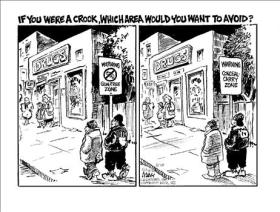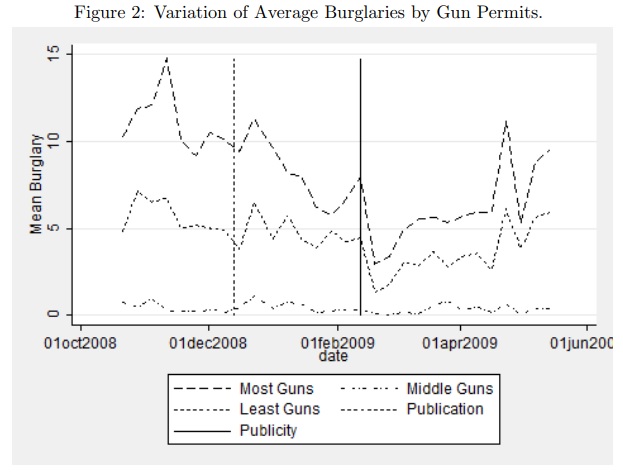Economics in part is the analysis of how people respond to incentives (do high tax rates encourage or discourage work, do trade barriers increase or decrease prosperity, etc).
This type of analysis also applies to the study of crime.
 For instance, do guns encourage crime (by giving bad people access to weapons) or discourage crime (by giving potential victims a means of protection)?
For instance, do guns encourage crime (by giving bad people access to weapons) or discourage crime (by giving potential victims a means of protection)?
My view is that bad people will get guns, even if they are illegal. As such, the only real-world impact of gun control is that law-abiding people are made more vulnerable.
And that means more crime. In other words, crooks respond to incentives.
Let’s look at some new scholarly evidence. Alessandro Acquisti of Carnegie Mellon University and Catherine Tucker of MIT have produced a new study that investigates whether criminals respond to data regarding the likelihood of armed victims.
The main takeaway is that more guns is correlated with less crime.
This paper explores…a case study of the publication of a gun ownership database in Tennessee. This information was made available due to a FOIA request by the local newspaper and made public online. We evaluate how information about the location and numbers of gun permit holders being made publicly available affected crime… Did the online publication of gun permit holders’ information deter, or increase, certain types of crimes?
Or did it simply displace crime from one area to another? We investigate this question using detailed crime and handgun carry permit data for Memphis and nearby areas, from before and after the newspaper’s publication of the permits. We evaluate how incidences of burglaries changed before and after the database was published and publicized, as a function of the number of guns in a zip code. Our analysis suggests a post-publicization relative decrease – both in absolute and in percentage terms – in burglaries in zip codes with higher numbers of gun permits, relative to zip codes with median numbers of permits, and a post-publicization relative increase in zip codes with fewer gun permits: our estimates suggest an 18% relative decrease of burglaries in those zip codes with the largest number of gun permits.
Wonkier readers may be interested in this chart, which maps burglary rates over time in neighborhoods with varying rates of gun ownership.
The authors explain what the numbers imply.
Figure 2 shows mean trends, over time, for burglaries in the period from October 2008 to May 2009. …the figure…suggests an upward trend in crimes across all zip codes in December, spiking around Christmas, followed by a downward trend in January. After the publicity around the database started intensifying in early February (solid vertical line), the downward trend seems to intensify. …From the perspective of our analysis, what matters is whether burglary trends in zip codes with more gun permits differ more from the trends in zip codes with lower numbers of gun permits after the publicization of the database, than they differed before. … zip codes with more gun permits experienced a larger decrease in burglaries relative to zip codes with fewer gun permits. …Relative to zip codes with the middle number of permits, zip codes with the highest concentration of permits experienced roughly 1.9 fewer burglaries per week/per zip code in the 15 weeks following the publicization of the database, and those with the lowest concentration experienced on average 1.4 more burglaries. Given that, on average, there were 9.7 burglaries per week in each of the top zip codes, our results imply a 20% relative decrease of burglaries in those zip codes.
For what it is worth, this issue is sort of like an IQ test.
On the margin, bad people are smart enough to target houses (and locations) where they perceive there is less likelihood of armed resistance.
But are our friends on the left smart enough to draw the obvious conclusion about public policy? For some of them, the answer is yes. For most of them, the answer is no.

[…] that question as an another version of my gun-control IQ […]
[…] Even when they get to do a make-up test, they still fail. […]
[…] Even when they get to do a make-up test, they still fail. […]
You’ve explained the information very clearly in this blog. If you want to know more about Louisiana Gun Permit so you can visit us.
[…] I have three IQ tests (here, here, and here) on gun control for my left-leaning […]
[…] criminals will have more incentive to engage in thuggish behavior once the law-abiding population is disarmed (as explained in this “IQ […]
[…] governments don’t do a good job of protecting us during times of […]
[…] governments don’t do a good job of protecting us during times of […]
[…] could argue that crime has dropped becausemore law-abiding people are now […]
[…] could argue that crime has dropped because more law-abiding people are now […]
Rather compare the rates of Violent Crime rather than Homicides. Violent crime is a lot more common than homicides so outliers cannot skew the picture.
When Colorado’s concealed carry law was enacted in 2003, the University of Colorado refused to allow their students to protect themselves, while Colorado State University allowed them to concealed carry. Since the external factors are similar, their very different results maintained for years give an eye-opening comparison of the effectiveness of being armed and able to defend yourself.
Encouraging concealed carry created an immediate drop of 47.7% in violent crime at Colorado State. But at CU Boulder, their defective strategy of banning guns to increase safety immediately increased violent crime by 10% instead.
How about internationally?
Gun-free Britain has SIX times more violent crime than well-armed America, up from FOUR times ten years earlier. And Democratic-run Cities all have far more violent crime than GOP cities. see lots more at:
http://www.DiscourageCriminals.net/compare-us-with-british-violent-crime/
This is fascinating because it studies burglaries not homicide.
I have always hesitated to embrace the idea of “More Guns; Less Crime” because I had always (mistakenly) thought of “crime” as “homicides”. This mislead my thinking.
Here is where my thinking was correct: Suppose a society where 100.0% of homicides were felons killing felons in rivalry disputes. In such a society, arm every law-abiding person. How much would homicides drop? Probably close to 0%.
Actual data is close to this. So far as we can tell, 80% – 90% of homicides seem to be minority ethnic males with criminal records killing each other. Quibble with the details, the fact is that law-abiding people killing other law-abiding people seems to be a material but modest part of the homicide problem.
Now, imagine how much the homicide problem would drop if every law-abiding person were armed? Arming the law-abiding could only have an impact on some of the 20% – 10% of homicides which were criminal-on-law-abiding cases. Cutting such cases in half (10% to 5%) would have so small effect on the total because the total is 80% – 90% criminal-on-criminal. Yes, there would be an effect. But it might be to small to be reliable.
This study takes a radically different view compared to my concentration on homicide. We can reasonably suppose that burglaries are mostly criminal-on-law-abiding-homes. Arming these householders could influence astute criminals. If so, the impact on their behavior could be significant and that significance would be large enough to confidently measure.
I’ve just make a compelling case for a right to guns in the home but not yet guns outside the home.
Turning to public carry, we have a philosophical issue. If a householder has a right to possess and use a gun to defend herself in her home, why does she not have a right to carry that gun outside her home? Why must she disarm when leaving her home when government does little to disarm her robber/rapist/murderer?
Look to Kenesaw, GA.
[…] Updating the IQ Test on Guns and Crime — International Liberty […]
Mr. Mitchell,
For those on the left, facts don’t matter. Power and control over folks like you and me are all that matter. Thus, the false phrase: “gun violence”. Violence is violence, and unlawful and immoral activity is at the root of it. A person can be just as violent with a screwdriver or ice pick, as with a firearm. But you know this.
Kevin
Susquehanna County, PA
Sent from my Behemoth Dell 690
Usually the advantage of a graph is that it makes a large amount of info graspable with minimal captioning. Here the caption is larger than the graph and both are as clear as mud.
Burglaries? I imagine there are a lot of those in Europe, also. But how about homicides? Most European countries have far fewer handguns in circulation and far less homicides. You can throw in Canada, Australia, New Zealand, and Japan as well. Coincidence? No serious person would believe that. And if you say the bad guys will always get guns, how come their bad guys don’t seem to? This issue is sort of like an IQ test. I haven’t seen too many on the right pass it.
With mandatory gun and ammunition insurance, victims could get no fault compensation like motor vehicles. Price the risk of harm, in the hands of particular persons, with particular weapons; and insurance companies will be able to use artificial intelligence, social media, household associates, education, community, and all other factors to predict risk. Manufactures will soon be selling guns with lower insurance risk.